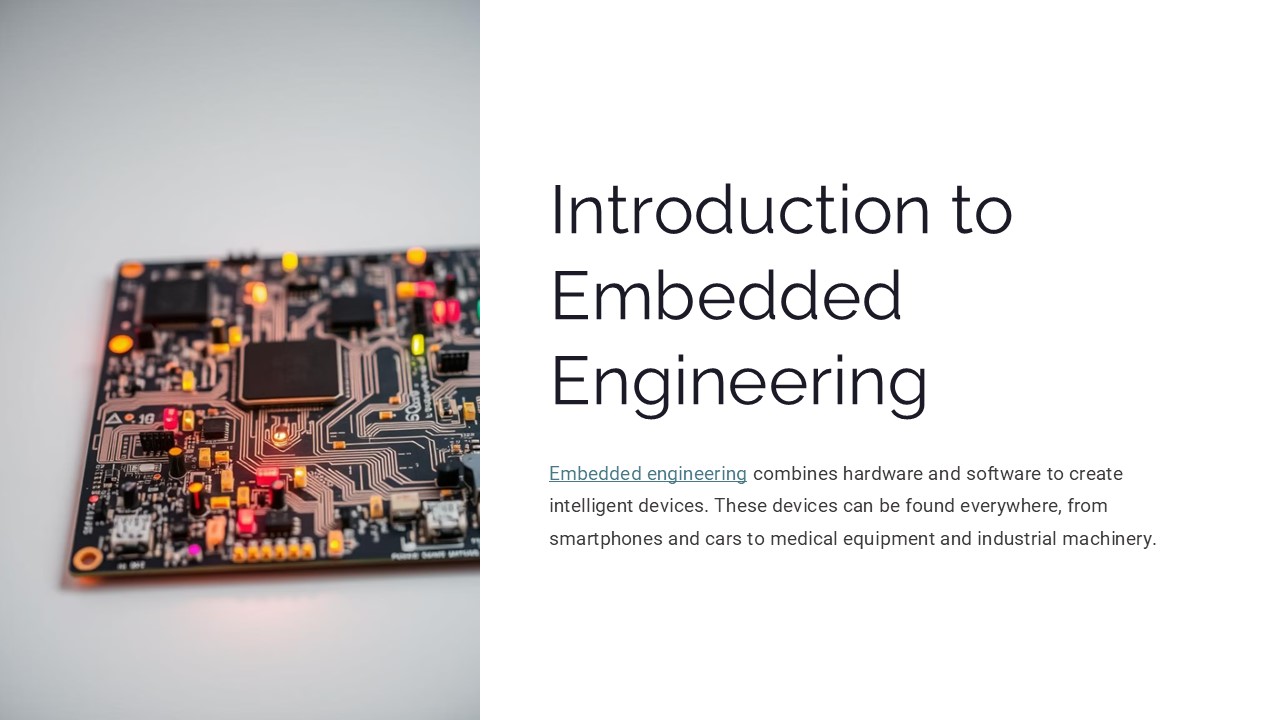Introduction to Embedded Engineering - PowerPoint PPT Presentation
Title:
Introduction to Embedded Engineering
Description:
Embedded engineering combines hardware and software to create intelligent devices. These devices can be found everywhere, from smartphones and cars to medical equipment and industrial machinery. – PowerPoint PPT presentation
Number of Views:0
Date added: 23 September 2024
Slides: 8
Provided by:
andrewsmith111
Category:
How To, Education & Training
Tags:
Title: Introduction to Embedded Engineering
1
Introduction to Embedded Engineering
Embedded engineering combines hardware and
software to create intelligent devices. These
devices can be found everywhere, from smartphones
and cars to medical equipment and industrial
machinery.
2
Hardware Design Principles
Microcontrollers
Sensors
1
2
The brain of embedded systems, they execute
instructions and control devices.
Gather data about the environment, providing
input to the microcontroller.
Actuators
Power Supply
3
4
React to commands from the microcontroller,
controlling physical elements.
Provides energy to operate the system, often
using batteries or external sources.
3
Microcontroller Architecture
Central Processing Unit (CPU)
Memory
Peripherals
Executes instructions and performs calculations.
Stores data and instructions.
Interface with the outside world.
- Program Memory (ROM/Flash)
- Timers
- Arithmetic Logic Unit (ALU)
- Data Memory (RAM)
- Serial Communication (UART, SPI)
- Control Unit
- Analog to Digital Converters (ADC)
4
Embedded Software Development
1
2
3
4
Requirements Analysis
Software Design
Coding and Testing
Deployment
Develop a software architecture and choose
programming languages.
Write code, test, and debug to ensure
functionality.
Install the software on the microcontroller and
configure settings.
Define the system's functionalities and
constraints.
5
Real-Time Operating Systems
Task Scheduling
Inter-task Communication
RTOS manage and prioritize tasks to ensure
efficient execution.
Allow tasks to share data and synchronize their
actions.
Resource Management
Time Management
Control access to shared resources, such as
memory and peripherals.
Provide precise timing for critical tasks,
ensuring real-time performance.
6
Debugging and Testing Techniques
Hardware Debugging
Software Debugging
Simulation and Emulation
Functional Testing
Use tools like oscilloscopes and logic analyzers
to analyze signals.
Employ breakpoints, logging, and tracing
techniques to identify errors.
Verify system functionality against defined
requirements.
Test software behavior without needing physical
hardware.
7
Trends and Future Directions in Embedded Systems
Internet of Things (IoT)
Artificial Intelligence (AI)
Connecting devices to the internet for data
sharing and remote control.
Integrating AI algorithms into embedded systems
for decision-making.
Cloud Computing
Cybersecurity
Offloading processing and storage to cloud
services for scalability and flexibility.
Protecting embedded systems from malicious
attacks and data breaches.































